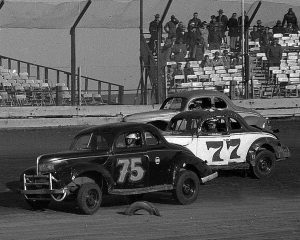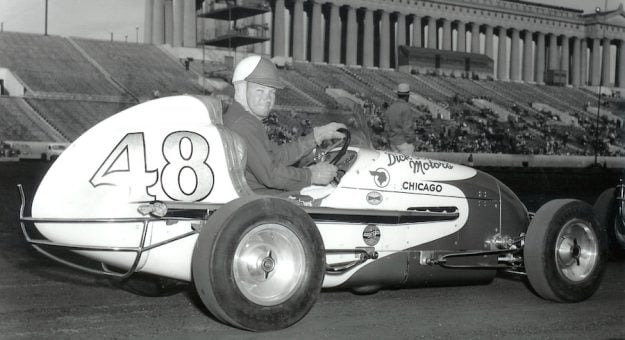Interesting to note, a number of drivers, including two-time feature winner and club headman Chuck Scharf, got attention from the Marion County Sheriff’s Department for operating unsafe vehicles on local highways as they drove their sometimes battered race cars home after a night of competition.
The Chicago-based organization also raced at Indiana’s Terre Haute Fastrack, Richmond Midget Stadium, Sun Valley Speedway, Kokomo Speedway and at Speedway Stadium, outside of Lafayette. General admission there was $1.
The 1949 season concluded with Don Odell winning three 300-lap contests at three different tracks.
Raceway Park continued to host the Championship Stock Car Club stockers for several more years with Hal Ruyle (1950) and Van Allen (1951) being named champions. Van Allen went on to win numerous track titles in the Chicago area. In 1952, Scharf and company turned their attention to late model, showroom stock racing, forming the Society of Autosport, Fellowship and Education organization, a touring stock car circuit that operated through 1955.

Another speed plant that saw the change was Soldier Field in Chicago. The mammoth stadium, which could hold more than 100,000 for various sporting contests, had been hosting weekly midget racing since 1946 and saw weekly crowds of more than 20,000 that first year.
The midgets began to see an attendance decline when hot rod racing was first introduced in 1947 and stock cars in 1949 — both under the watchful eye of Andy Granatelli and his Hurricane racing group.
Future Indianapolis 500 winners Pat Flaherty (1956) and Jim Rathmann (1960), both transplanted Californians, came to Chicago to compete in hot rods and, later, in stock cars at Soldier Field. Both Flaherty and Rathmann, along with other Californians Don Freeland, Chet Bingham and Rathmann’s older brother, Dick, considered it “big money” that was being offered by Granatelli and the Soldier Field promotional team.
Flaherty and Rathmann, both champions in hot rods and stock cars at Soldier Field, drove for Granatelli in the Indianapolis 500.
In 1950, the stock cars at Soldier Field were averaging more than 20,000 fans per night in early July, while the weekly Sunday evening midget programs had a hard time drawing 5,000.
However, the midgets did draw 36,875 to watch Indiana’s Paul “Potsy” Goacher win the always-packed, annual Chicago Park District Police Benevolent event in September. Stock cars were also part of the program that night and it was the last time midgets were part of the big race program at Soldier Field.
Like Soldier Field, Illinois’ Rockford Speedway hosted weekly American Automobile Ass’n midget racing. The quarter-mile paved track opened in May 1948 with the midgets taking center stage on Wednesday nights.
In July, Granatelli’s hot rods were added to the weekly schedule, competing on Sundays. The hot rods, playing to bigger crowds, raced through October with the midgets ending their season in early September.
In 1949, midgets and hot rods were set to compete with stock cars added in late June. By June, the weekly AAA midget races were canceled at the Rockford oval with only two open-wheel programs in the books, both won by California’s Eddie Haddad.
Jim Rathmann was Rockford’s track champion in 1949 with Pat Flaherty grabbing stock car honors in 1950.
The transition from weekly midget racing to weekly short-track, stock car racing came about in the late 1940s and early 50s at various tracks throughout the country, especially in the Chicagoland and Midwest areas.
This story appeared in the March 1, 2023 edition of the SPEED SPORT Insider.

